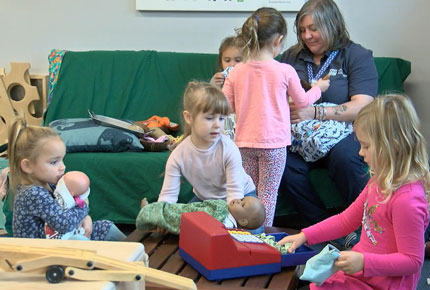Fostering Independent Decision-Making
by Allowing Free Movement During Center Time
(This video has captions. You can turn them on by clicking the CC icon at the bottom of the video.)
Download a printable transcript in English and Spanish.
Anne Marie Boroughs, Director and Lead Teacher, Sea School: We don’t set limits on children in the centers. They can go move about to the different centers freely. It goes it goes right along with all the other expectations we have, [which] is: we want to include everyone; we don’t exclude people.
Child 2: Mmm-hmm.
Child 1: They both look pretty.
Anne Marie Boroughs: But we also have to realize that they have to think for themselves, and they have to say, “Hey, if we have a game that we’re playing, and there’s four players, can we have eight people here?”
Anne Marie: You’re going grocery shopping? Alright.
Anne Marie Boroughs: I’m not going to tell a child, “No, you can’t bring the MagnaTiles over here, because they belong here.”
Anne Marie: You’re back?
Child: I got some toys.
Anne Marie Boroughs: There are reasons sometimes, like you wouldn’t want to put MagnaTiles in the water table, but why not? Explain it. And once they know why they can’t do something, that’s fine. And we find that when they have that kind of freedom, they just become better decision-makers.
Child: What are you doing?
Anne Marie Boroughs: We just basically give this huge, open opportunity for them to navigate these situations on their own.
Child 1: You want to make salad with me?
Child 2: Ok. What ingredients do you need?
Anne Marie Boroughs: And it is scary for some teachers. They’re like, “What’s going to happen? Are they going to make their way back?” Guess what? When we do cleanup time, those kids put them back. So I don’t see any reason why they shouldn’t be able to move about freely.
© 2021 Center for Early Childhood Education at Eastern Connecticut State University.
May be reprinted for educational purposes.



